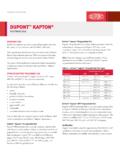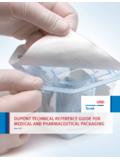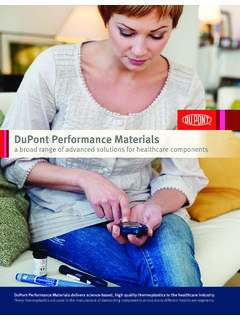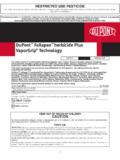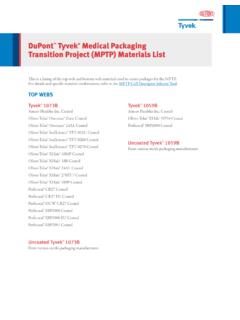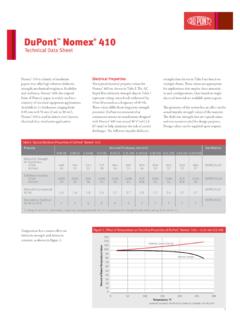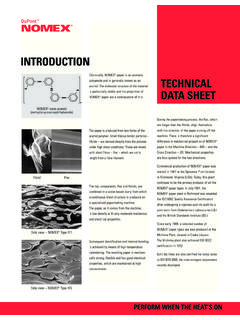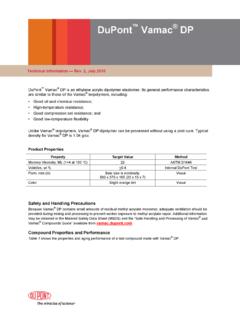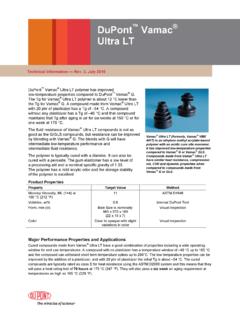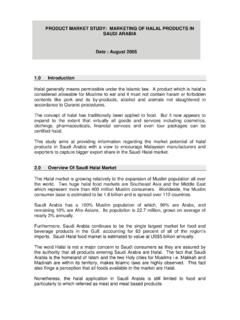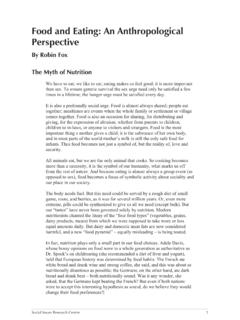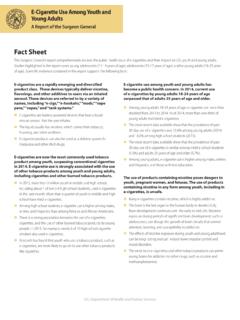Transcription of DuPont Tedlar
1 PPDuPont Tedlar polyvinyl fluoride filmDescription DuPont Tedlar polyvinyl fluoride film has outstanding mechanical properties; inertness to a variety of chemicals and solvents; and anti-stick properties that make it an excellent release film for epoxies, phenolics, polyesters, and rubber compounds. Tedlar does not contain silicones, which can cause adhesion and delamination problems in Release Film Applicationsfinished parts. Tedlar also has good temperature resis-tance. In most applications, Tedlar can withstand temper-atures in excess of 177 C (350 F) for several hours. Tedlar release films are available in 25 and 51 m (1 and 2 mil) thicknesses as clear, translucent, or opaque white film and in several surface finishes, as shown in Table Thickness, m (mil) GlossColorSpecular Gloss 60 Surface Roughness min, avg, m ( in)Tenacity, min* MPa kpsiWeb Strength* N/m, width lb/in, widthElongation (MD) min, %*Approximate Yield m2/kg ft2/lb 25 ( ) (7) ( ) (15) ( ) (25)6291575910 ( ) (10)8312210 ( ) (8) ( ) (10) *Room temperatureTable 1 Physical Properties of DuPont Tedlar PVF Release FilmsApplications and Film TypesPrinted Circuit BoardsWithin the broad family of DuPont Tedlar PVF film products, a variety of films have been specially formulated to serve the needs of the printed circuit board industry.
2 Whether the application is in laminate production, mass lamination, or multilayer fabrication, these Tedlar release films provide outstanding release from phenolic and epoxy resins as well as copper and caul plate surfaces, either hot or is a widely used release product for FR-4 epoxy-glass systems. Besides its ease of release, high tensile strength, and tear resistance, the film imparts a matte finish to the cured resin surface. This is accom-plished by the addition of inert pigments to the film during manufacture to achieve a desired surface roughness. The resulting transfer of this texture from the Tedlar to the resin surface enhances the adhesion of legend inks, protective masks, and additional layers of resin or prepreg to the laminate. TMR10SM3 is offered where an even rougher surface texture is desired and also provides a broader operating range due to its higher thermal above Tedlar printed circuit release products are designed to minimize plate scumming and to withstand normal epoxy and phenolic press cycles and temperatures without embrittlement or such as TTR20SG4 and TMR20SM3 are frequently used for release in the manufacture of flexible or rigid-flex printed wiring boards due to their conformability, tough-ness, and inertness to bonding adhesives.
3 All Tedlar films can also be obtained with one side treated to accept adhesives or other bonding materials for the fabrication of specialty release PartsAircraft manufacturers and their subcontractors use TTR10SG3 and TTR20SG4 in hand lay-up and vacuum bagging operations for curing epoxy and polyester prepreg parts where inspection of the part before or after applica-tion of heat and pressure is desirable. When it is essential to be able to tell if all the release film has been stripped from the part, a pigmented film may be preferred. Of the standard types of Tedlar , TTR20SG4 has the best form-ability for this operation. Tapes and perforated Tedlar are available from converters for special ApplicationsElectrical equipment manufacturers have used a variety of Tedlar films to contain resin overflow during autoclave curing of motor windings and coils. Most popular among these films have been TWH20SS3 and TTR20SG4 because of their high tensile strengths.
4 TWH10SS3, TTR10SG3, TPC10SM3, and TMR10SM3 are used in applications where a thinner film is in the Rubber IndustryTransparent TTR10SG3 and TTR20SG4, as well as translu-cent TPC10SM3 and TMR10SM3, are often used as sub-strates for screen-printed transfer labels to identify rubber hoses and fan belts. Tedlar film has a higher use tempera-ture than triacetate and is not affected by moisture, unlike nylon films. For this reason, TMR10SM3 is frequently used as a release film to prevent sticking to the mandrel during steam curing of fan belts. The rubber industry has found TTR10SG3 to be a good processing aid in the resurfacing of rubber laminating and printing rolls. TWH10SS3 is used in patching and vulcanizing kit StaticIn unwinding, sheeting, or handling operations on thin plastic films, static charges can be built up. Static discharg-es across the film result in etching the surface, making it susceptible to sticking in those areas.
5 It may be necessary to add commercial static eliminator bars or grounded me-tallic tinsel to the handling equipment for control of static discharge. TPC10SM3 and TMR10SM3 have the least tendency toward static DegradationThermal degradation of Tedlar PVF film results in embrit-tlement, browning, and finally, charring of the film. Acidic conditions catalyze the degradation. If press plates be-come contaminated with charred Tedlar , repeated use will cause repeated charring. If charring occurs, press plates should be cleaned thoroughly and given an alkaline rinse of a dilute water solution of sodium carbonate or sodium and ResinsTedlar is being successfully used with a wide variety of epoxy resins. However, the presence of boron fluoride type complex catalysts in the final cure cycle can cause sticking and, at higher temperature conditions, decomposi-tion of the a current Safety Data Sheet or Article Informa-tion Sheet for guidance on the appropriate measures for 01/13 Copyright 2013 DuPont or its affiliates.
6 All rights reserved. The DuPont Oval Logo, DuPont , The miracles of science , and Tedlar , are registered trademarks or trademarks of E. I. du Pont de Nemours and Company or its PART OF THIS MATERIAL MAY BE REPRODUCED, STORED IN A RETRIEVAL SYSTEM OR TRANSMITTED IN ANY FORM OR BY ANY MEANS ELECTRONIC, MECHANICAL, PHOTOCOPYING, RECORDING OR OTHERWISE WITHOUT THE PRIOR WRITTEN PERMISSION OF information set forth herein is furnished free of charge and is based on technical data that DuPont believes to be reliable. It is intended for use by persons having technical skill, at their own discretion and risk. The handling precaution information contained herein is given with the understanding that those using it will satisfy themselves that their particular conditions of use present no health or safety hazards. Because conditions of product use are outside our con-trol, we make no warranties, express or implied, and assume no liability in connection with any use of this information.
7 As with any material, evaluation of any compound under end-use conditions prior to specification is essential. Nothing herein is to be taken as a license to operate under or a recommendation to infringe any : Do not use in medical applications involving permanent implantation in the human body or contact with internal body fluids or tissues. For other medical applications, see DuPont Medical Caution Statement, : Tedlar is not approved for use in ultralight aircraft
